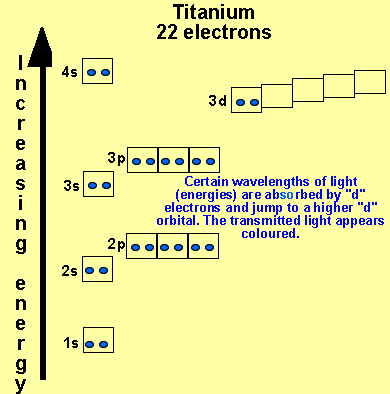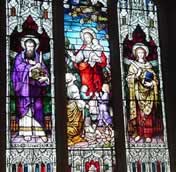Transition metals
Coloured compounds and oxidation states.

Transition metals form coloured compounds and are widely used as pigments in paint and to colour glass. In transition metal compounds anions take up geometric arrangements around the positive metal ion. This arrangement tends to disrupt the "d" subshell to the point where the five orbitals vary slightly in energy. As white light strikes the compound enough energy is present in photons, hitting the electrons, to promote them to a higher energy orbital. As electrons absorb energy to rise to a higher orbital they make the compound appear coloured, as the reflected light is missing certain wavelengths that correspond to the energy difference between the orbitals.
See the animation on the left.
ZInc has the electronic configuration 1s2,
2s2, 2p6, 3s2, 3p6, 3d10,
4s2. It appears that all the 3d orbitals are full. No
electron can jump between "d" orbitals and this is why Zinc
does not form coloured compounds.

Transition
metals are used to colour glass and produce ornamental stain glass windowsZinc
has
Transition metals display a range of oxidation states with values of +2 or +3 being common. Higher oxidation states of +6 and +7 exist only in oxides. Manganese exhibits a range of oxidation states from +2 to +7.
|
Compound
|
MnCl2
|
MnCl3
|
MnO2
|
K2MnO4
|
KMnO4
|
|
Oxidation
state of Mn
|
+2
|
+3
|
+4
|
+6
|
+7
|
The fact that
the 4s and 3d subshells have similar energy the atom can lose electrons
from both of these subshell and still form stable ions.
A neutral atom of Mn has the electronic configuration 1s2,
2s2, 2p6, 3s2, 3p6, 3d5,
4s2 In the compound KMnO4 the Mn atom
exhibits an oxidation state of +7 and has the electronic configuration
1s2, 2s2, 2p6, 3s2, 3p6
after having lost the 4s and the 3d electrons.